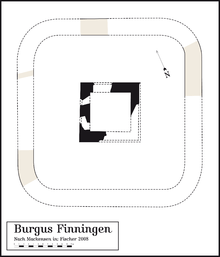Burgus


.jpg)



A burgus (Latin, plural burgi ) or turris ("tower")[1] is a small, tower-like fort of the Late Antiquity, which was sometimes protected by an outwork and surrounding ditches.
Burgus was a term used in the later period of the Roman Empire and for buildings particularly in the Germanic provinces.[2]
Definition
Burgus is a loanword from the Romans, which in turn was originally a Germanic name. The Latin word burgus comes from the same language family as the Greek pyrgos (Ancient Greek: πύργος). It has been used in different ways, in the military sector it could refer to both a single tower and to other smaller fortifications. The feature of this definition, however, is that it is based on a function, in this context, particularly on the expression burgus speculatorius (observation).[3]
The word burgus is often seen in Latin texts of the Late Antiquity: e.g. at the end of the 4th century by Flavius Vegetius Renatus in his Epitoma rei militaris ("Survey of the Military") and in the 418 AD publication, historiae contra paganos ("Chronicles of the Pagans") by the Spanish cleric, Orosius. The burgus at Mittelstrimmig is attested by an inscription from the year 270 AD. The word, which the Romans borrowed from the Germanic language, is found in Roman military parlance from the end of the 2nd century.[4]
Development and function
From 369 AD, under Valentinian, an extensive fortress building programme was set under way on the borders of the Empire. This entailed the construction of two-storey, rectangular towers (on average 8–12 m wide and 10–12 m high), so-called residual forts (German: Restkastellen) in limes camps that had already been largely denuded of their complements, and granaries (horrea) envisaged for border troops. These burgi were essentially a development of the limes towers of the middle imperial period and consisted, in the case of the larger examples, of a tower-like central structure and outer fortifications (a rampart, defensive wall or palisade, surrounded by several ditches). A conspicuous feature of buildings of this type of the Late Antiquity is the significant increase in size of the central tower. Most of these new fortifications were abandoned or destroyed, however, by about the middle of the 5th century.
In the literature, however, all kinds of Late Antiquity period buildings, such as smaller watchtowers, fortlets (castella), civilian refuges at villae rusticae (estates) and fortified docks for riverboats, especially on Upper Rhine and Danube, were also called burgi. Burgi were identified, on the one hand, along border rivers and, on the other hand, along major roads (via burgi), where they are likely to have been used mainly for observation tasks, as forward defensive positions or for visual signalling communications.
The troops of these small military posts carried out policing duties on the roads and looked after the maintenance of law and order in the villages.[5] Where the burgi were situated in valleys, either at their lower ends or at river confluences, they served as barriers. If they were situated between two castles, they were used inter alia in emergencies as a places of retreat. Larger burgi such as the one at Asperden, probably served as refuge castles for the surrounding population and as a granary.
A special type of burgus were the late Roman "landing stage" burgi (German: Ländeburgus). In addition to the rectangular central building erected near the river bank, they had crenellated walls that extended up to or into the river like pincers, thus protecting the landing stage or berthing bay for cargo ships and river patrol boats.
See also
References
- ↑ CIL VIII, 2546; CIL VIII, 2548. Babylonian Talmud, Mo'eds Katan 28b
- ↑ 'CIL III, 3385 and AE 1910, 145
- ↑ Georg Goetz:. Corpus glossariorum Latinorum, Volume II, 426, 26.
- ↑ Inter alia, on inscriptions from the reign of the emperor Commodus (180-192) from the Pannonian Danubian Limes: CIL III, 3385 and AE 1910, 145
- ↑ Talmud v. Jerusalem, Eroubin V, 1
Literature
- Thomas Fischer: Die Römer in Deutschland. Theiss, Stuttgart, 1999, ISBN 3-8062-1325-9.
- Jörg Fesser: Frühmittelalterliche Siedlungen der nördlichen Vorderpfalz. Dissertation University of Mannheim, 2006.
- Dieter Planck, Andreas Thiel: Das Limes-Lexikon, Roms Grenzen von A-Z. Beck, Munich, 2009, ISBN 978-3-406-56816-9, p. 21.
- Yann Le Bohec: Die römische Armee. Steiner, Stuttgart, 1993, ISBN 3-515-06300-5, pp. 175–177.
- Ute Naberfeld: Rekonstruktionsversuch des spätrömischen Burgus von Asperden. In: An Niers und Kendel. 11 (1984), pp. 16–17.
- Baden State Museum (publ.): Imperium Romanum, Römer, Christen, Alamannen-Die Spätantike am Oberrhein. Theiss, Stuttgart, 2005, ISBN 3-8062-1954-0.
| Look up [[wiktionary:|]] in Wiktionary, the free dictionary. |